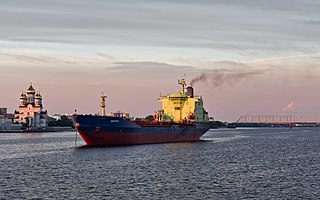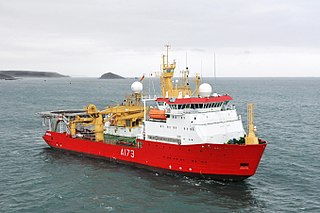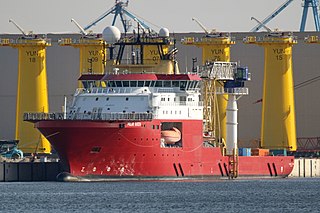
HMS Endurance was an icebreaker that served as the Royal Navy ice patrol ship between 1991 and 2008. Built in Norway as MV Polar Circle, she was chartered by the Royal Navy in 1991 as HMS Polar Circle, before being purchased outright and renamed HMS Endurance in 1992 as a replacement for the previous HMS Endurance whose hull had been weakened by striking an iceberg.

An icebreaker is a special-purpose ship or boat designed to move and navigate through ice-covered waters, and provide safe waterways for other boats and ships. Although the term usually refers to ice-breaking ships, it may also refer to smaller vessels, such as the icebreaking boats that were once used on the canals of the United Kingdom.
Kværner was a Norwegian engineering and construction services company that existed between 1853 and 2005. In 2004, it was amalgamated into the newly formed subsidiary of Aker ASA - Aker Kværner, which was renamed Aker Solutions on 3 April 2008. Kværner re-emerged on 6 May 2011, when the EPC part of Aker Solutions took the Kværner name. The new Kværner company was listed on the Oslo Stock Exchange on 8 July 2011.

Aker Solutions ASA engineers and builds energy infrastructure while providing a range of products and consultancy services to low-carbon and renewable energy projects. Based in Oslo, the company's offerings to the energy industry include the systems and services required to de-carbonize oil and gas production, build wind-to-grid infrastructure and engineer CO2 capture and sequestration.

MSV Fennica is a Finnish multipurpose icebreaker and offshore support vessel. Built in 1993 by Finnyards in Rauma, Finland and operated by Arctia Offshore, she was the first Finnish icebreaker designed to be used as an escort icebreaker in the Baltic Sea during the winter months and in offshore construction projects during the open water season. Fennica has an identical sister ship, Nordica, built in 1994.

The RV Polar Duke is a 219-foot ice-strengthened research vessel built in 1983. Polar Duke was designed specifically for scientific research with wet and dry laboratories, and an electronic workshop and laboratory. The hull is constructed similar to that of an icebreaker, but the ship isn’t as powerful as an icebreaker. It was originally equipped with a stern A-frame crane and helicopter deck; these were both removed in a major refit in 1998.

MT Varzuga was an ice-strengthened product tanker that sailed under the Finnish flag in 1977–2003 and under the Russian flag in 2003–2021. After her modernization in 1993, she became the first merchant ship to be equipped with Azipod, an electric azimuthing propulsion unit developed in Finland in the late 1980s. She was also the first non-Soviet ship to transit the Northern Sea Route.
A double acting ship is a type of icebreaking ship designed to travel forwards in open water and thin ice, but turn around and proceed astern (backwards) in heavy ice conditions. In this way, the ship can operate independently in severe ice conditions without icebreaker assistance but retain better open water performance than traditional icebreaking vessels.

Vladimir Ignatyuk is a Russian icebreaking anchor handling tug supply vessel. She was built by Burrard-Yarrows Corporation in Canada in 1983 as Kalvik as part of an Arctic drilling system developed by BeauDril, the drilling subsidiary of Gulf Canada Resources. After the offshore oil exploration in the Beaufort Sea ended in the early 1990s, she was sold to the Canadian shipping company Fednav in 1997 and renamed Arctic Kalvik. In 2003, she was purchased by Murmansk Shipping Company and transferred to Russia.

HMS Protector is a Royal Navy ice patrol ship built in Norway in mid 2000. As MV Polarbjørn she operated under charter as a polar research icebreaker and a subsea support vessel. In 2011, she was chartered as a temporary replacement for the ice patrol ship HMS Endurance and was purchased by the British Ministry of Defence in early September 2013. As DNV Ice Class 05 the vessel can handle first year ice up to 0.5 metres (20 in).

MSV Botnica is a multipurpose offshore support vessel and icebreaker built by Finnyards in Rauma, Finland, in 1998. She was the newest and technically most advanced state-owned icebreaker of Finland until 2012, when she was sold to the Port of Tallinn for 50 million euro. Botnica is used as an escort icebreaker in the Baltic Sea during the winter months, but carries out subsea and offshore construction works worldwide during the open water season.

CCGS Sir Humphrey Gilbert is a former Canadian Coast Guard light icebreaker and buoy tender that was later sold to a private owner and renamed Polar Prince. The ship entered service with the Department of Transport Marine Service in 1959 and transferred to the newly created Canadian Coast Guard in 1962, active until 2001. The icebreaker was sold to private interests in Newfoundland and renamed Polar Prince, sitting mostly idle until resold in 2009 to GTX Technology Canada Limited for service in the Arctic Ocean as a commercial icebreaker. In 2017, the vessel was temporarily rechristened Canada C3 and used for a high-profile voyage around Canada's three maritime coasts as part of the nation's 150th anniversary. In November 2021, the ship was purchased by Miawpukek Horizon Maritime Service Ltd, a joint venture between Horizon Maritime and the Miawpukek First Nation and chartered for educational and research expedition use.

MSV Nordica is a Finnish multipurpose icebreaker and offshore support vessel. Built in 1994 by Finnyards in Rauma, Finland, and operated by Arctia Offshore, she and her sister ship Fennica were the first Finnish icebreakers designed to be used as escort icebreakers in the Baltic Sea during the winter months and in offshore construction projects during the open water season.

Vyborg Shipyard PJSC is a shipbuilding company located in Vyborg, Russia. The company has a focus on icebreakers and other icegoing vessels for arctic conditions, but the company has also built deep sea semi-submersible floating drilling and production platforms for exploration of oil and gas offshore fields. Vyborg Shipyard employs more than 1,500 people.
Miscaroo was an icebreaking anchor handling tug supply vessel built by Vancouver Shipyards for BeauDril, the drilling subsidiary of Gulf Canada Resources, in 1983. She was part of a fleet of Canadian icebreakers used to support offshore oil exploration in the Beaufort Sea. In the 1990s, the vessel was acquired by Canadian Marine Drilling (Canmar) and renamed Canmar Miscaroo. In 1998, she was purchased by Smit International and served in the Sakhalin oil fields as Smit Sakhalin until 2017 when the 34-year-old icebreaker was sold for scrapping in China.
Zhong Shan Da Xue Ji Di is a Chinese icebreaker owned by the Sun Yat-sen University. She was built in 1983 as an icebreaking anchor handling tug supply vessel (AHTS) Ikaluk for BeauDril, the drilling subsidiary of Gulf Canada Resources, to support offshore oil exploration in the Beaufort Sea. In the 1990s, the vessel was acquired by Canadian Marine Drilling (Canmar) and renamed Canmar Ikaluk. In 1998, she was purchased by Smit International and served in the Sakhalin oil fields as Smit Sibu. In 2009, she was acquired by FEMCO Management and in 2012 given back her original name. Ikaluk was sold to China in February 2018 and renamed Beijing Ocean Leader. In late 2021, the vessel was acquired by its current owner.

RV Falkor (too) is an oceanographic research vessel refitted in 2021–2022 from the former multi-role offshore support vessel MS Polar Queen. The ship was purchased by the Schmidt Ocean Institute in March 2021. It replaced the RV Falkor.

Horizon Maritime Services Ltd is a company which provides vessels and offshore services for arctic duty in Canada and Norway. It is based in St. John's, Newfoundland and Labrador, and its joint ventures include partnerships with two First Nations, the Miawpukek and the Heiltsuk ; in addition, Horizon operates joint ventures with Kotug as Kotug Canada and with Bourbon as Bourbon Horizon.
Idun is a future Swedish icebreaker. The ship was built in 2006 as Polar Pevek and stationed at the De-Kastri terminal in the Russian Far East. Following the Russian invasion of Ukraine in 2022, the vessel's Norwegian owner withdrew from Russia and renamed it Polar Circle. In 2024, the Swedish Maritime Administration decided to acquire the ship.













